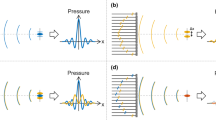Abstract
Power amplifiers (PAs) are used to produce high-voltage excitation signals to drive ultrasonic transducers. A larger dynamic range of linear PAs allows higher contrast resolution, a highly desirable characteristic in ultrasonic imaging. The linearity of PAs can be improved by reducing the nonlinear harmonic distortion components of high-voltage output signals. In this paper, a linearizer circuit is proposed to reduce output signal harmonics when working in conjunction with a PA. The PA performance with and without the linearizer was measured by comparing the output power 1-dB compression point (OP1dB), and the second- and third-order harmonic distortions (HD2 and HD3, respectively). The results show that the PA with the linearizer circuit had higher OP1dB (31.7 dB) and lower HD2 (−61.0 dB) and HD3 (−42.7 dB) compared to those of the PA alone [OP1dB (27.1 dB), HD2 (−38.2 dB), and HD3 (−36.8 dB)] at 140 MHz. A pulse-echo measurement was also performed to further evaluate the capability of the linearizer circuit. The HD2 of the echo signal received by the transducer using a PA with the linearizer (−24.8 dB) was lower than that obtained for the PA alone (−16.6 dB). The linearizer circuit is capable of improving the linearity performance of PA by lowering harmonic distortions.










Similar content being viewed by others
References
Shung, K. K. (2005). Diagnostic ultrasound: Imaging and blood flow measurements. Boca Raton, FL: CRC Press.
Choi, H., Li, X., Lau, S.-T., Hu, C.-H., Zhou, Q., & Shung, K. K. (2011). Development of integrated preamplifier for high-frequency ultrasonic transducers and low-power handheld receiver. IEEE Ultrasonics, Ferroelectrics, and Frequency Control, 58, 2646–2658.
Jang, J., Tornblad, O., Arnborg, T., Chen, Q., Banerjee, K., Yu, Z., et al. (2001). RF LDMOS characterization and its compact modeling. In Proceedings of IEEE MTT-S international microwave symposium digest (Vol. 2, pp. 967–970).
Aarts, A. C. T., & Kloosterman, W. J. (2006). Compact modeling of high-voltage LDMOS devices including quasi-saturation. IEEE Transactions on Electron Devices, 53, 897–902.
Choi, H., & Shung, K. K. (2014). Novel power MOSFET-based expander for high frequency ultrasound systems. Ultrasonics, 54, 121–130.
Vuolevi, J., & Rahkonen, T. (2003). Distortion in RF power amplifiers. Norwood, MA: Artech House.
Lee, T. H. (2004). The design of CMOS radio-frequency integrated circuits. Cambridge: Cambridge University Press.
Tang, S. C., & Clement, G. T. (2008). A harmonic cancellation technique for an ultrasound transducer excited by a switched-mode power converter. IEEE Ultrasonics, Ferroelectrics, and Frequency Control, 55, 359–367.
Gao, Z., & Gui, P. (2012). A look-up-table digital predistortion technique for high voltage power amplifiers in ultrasonic applications. IEEE Ultrasonics, Ferroelectrics, and Frequency Control, 59, 1550–1557.
Yamauchi, K., Mori, K., Nakayama, M., Mitsui, Y., & Takagi, T. (1997). A microwave miniaturized linearizer using a parallel diode with a bias feed resistance. IEEE Transactions on Microwave Theory and Techniques, 45, 2431–2435.
Nader, C., Landin, P. N., Van Moer, W., Bjorsell, N., Handel, P., & Ronnow, D. (2012). Peak-power controlling technique for enhancing digital pre-distortion of RF power amplifiers. IEEE Transactions on Microwave Theory and Techniques, 60, 3571–3581.
Xie, S., Padi, V., Heikman, S., Shen, L., Chini, A., Mishra, U. K., et al. (2004). High linearity GaN HEMT power amplifier with pre-linearization gate diode. In Proceedings of IEEE performance development (pp. 223–228).
Cripps, S. C. (2002). Advanced techniques in RF power amplifier design. Norwood, MA: Artech House.
Minasian, R. A. (1983). Power MOSFET dynamic large-signal model. In IEE Proc-1. Solid state and electron devices (Vol. 130, pp. 73–79).
Taniguchi, E., Maeda, K., Ikushima, T., Sadahiro, K., Itoh, K., Suematsu, N., et al. (2003). Dual bias feed SiGe HBT low noise linear amplifier. IEEE Transactions on Microwave Theory and Techniques, 51, 227–230.
Razavi, B. (2003). RF microelectronics. Upper Saddle River: Prentic Hall.
Diodes Incorporated. (2003). N-channel enhancement mode MOSFET.
Cripps, S. C. (2006). RF power amplifiers for wireless communications. Norwood, MA: Artech House.
Choi, H., Yang, H. C., & Shung, K. K. (2014). Bipolar-transistor-based limiter for high frequency ultrasound systems. Ultrasonics, 54, 754–758.
Acknowledgments
The authors would like to thank Mr. Thomas Cummins for his editing contribution. This project was supported by National Institutes of Health Grant #P41-EB002182.
Author information
Authors and Affiliations
Corresponding author
Rights and permissions
About this article
Cite this article
Choi, H., Jung, H. & Shung, K.K. Power Amplifier Linearizer for High Frequency Medical Ultrasound Applications. J. Med. Biol. Eng. 35, 226–235 (2015). https://doi.org/10.1007/s40846-015-0026-7
Received:
Accepted:
Published:
Issue Date:
DOI: https://doi.org/10.1007/s40846-015-0026-7




